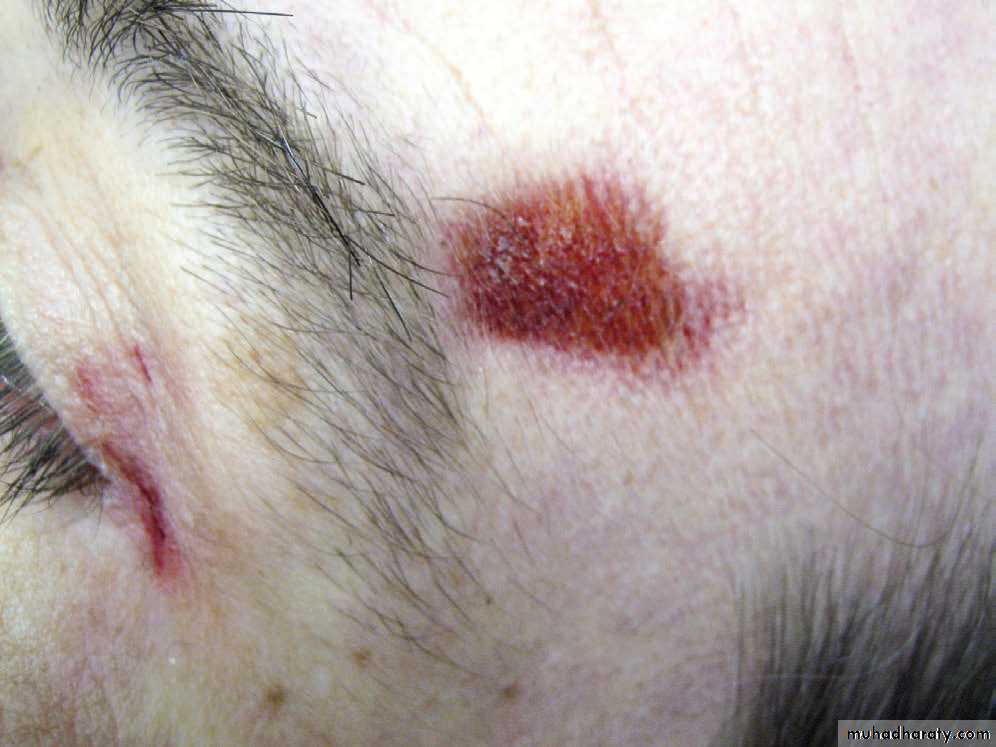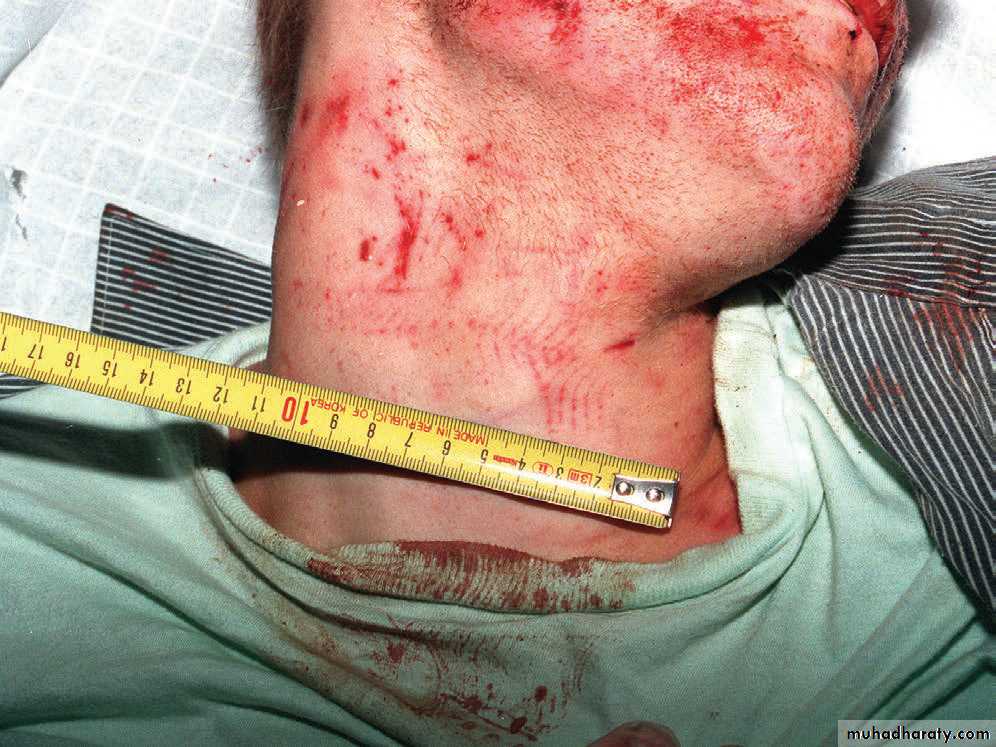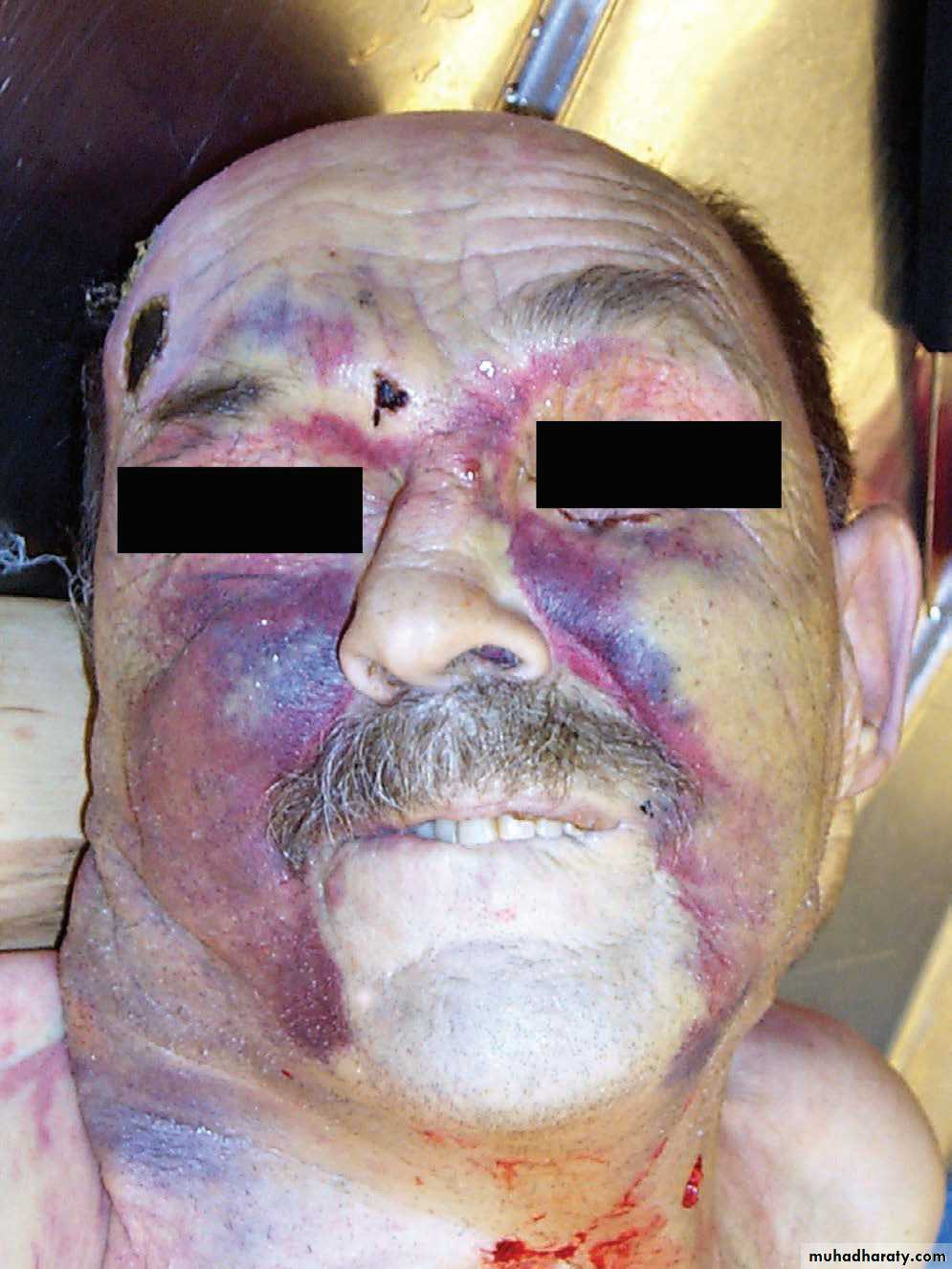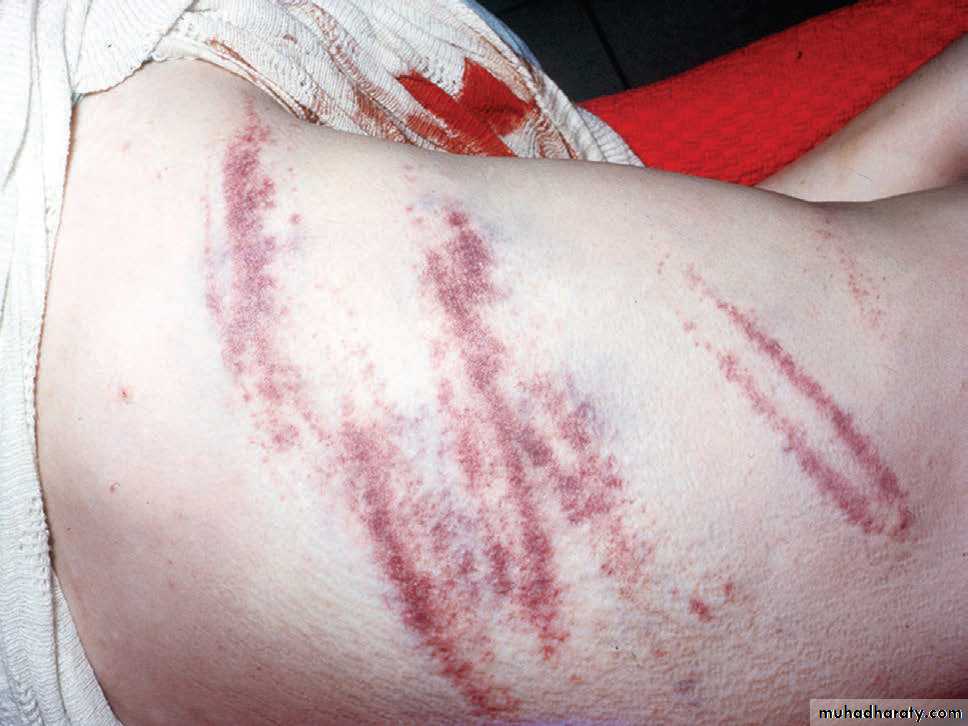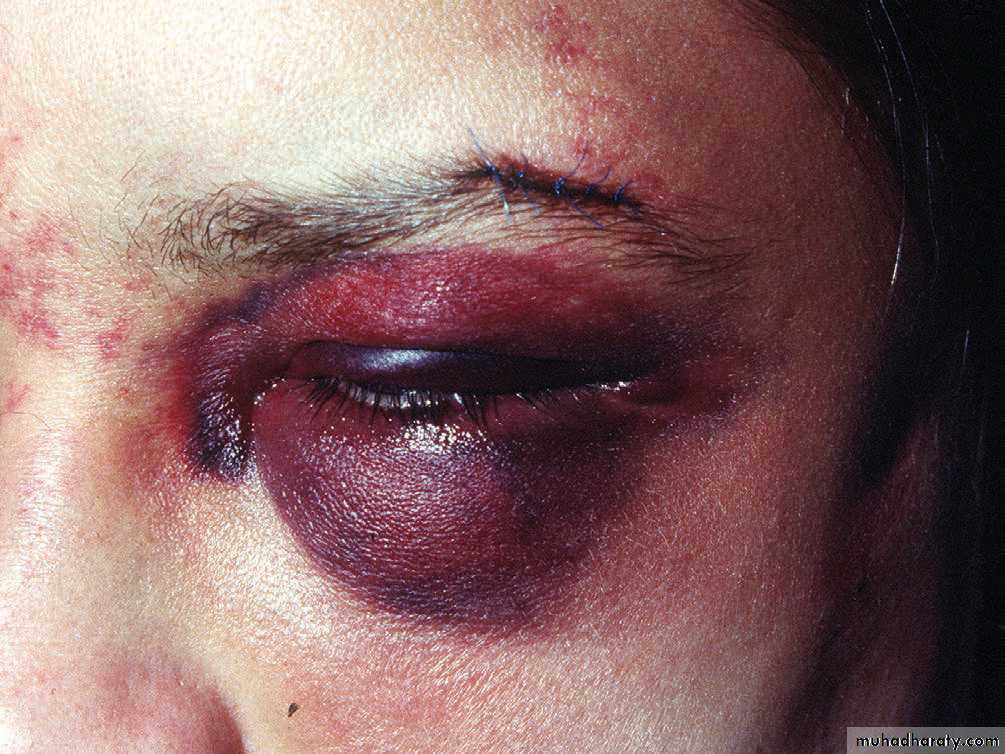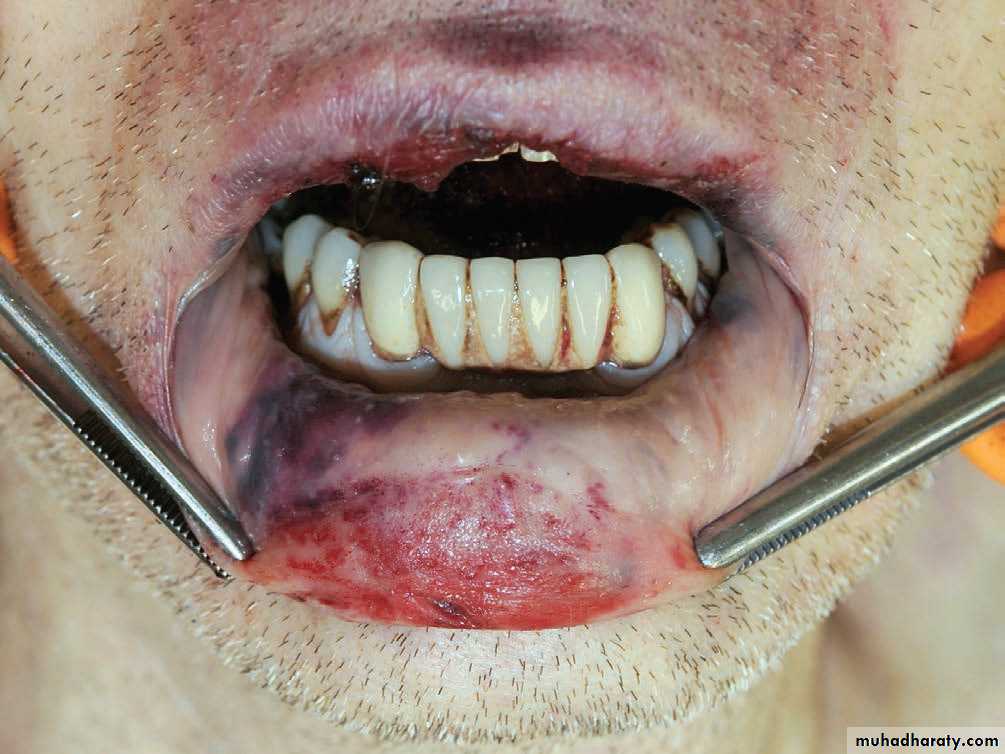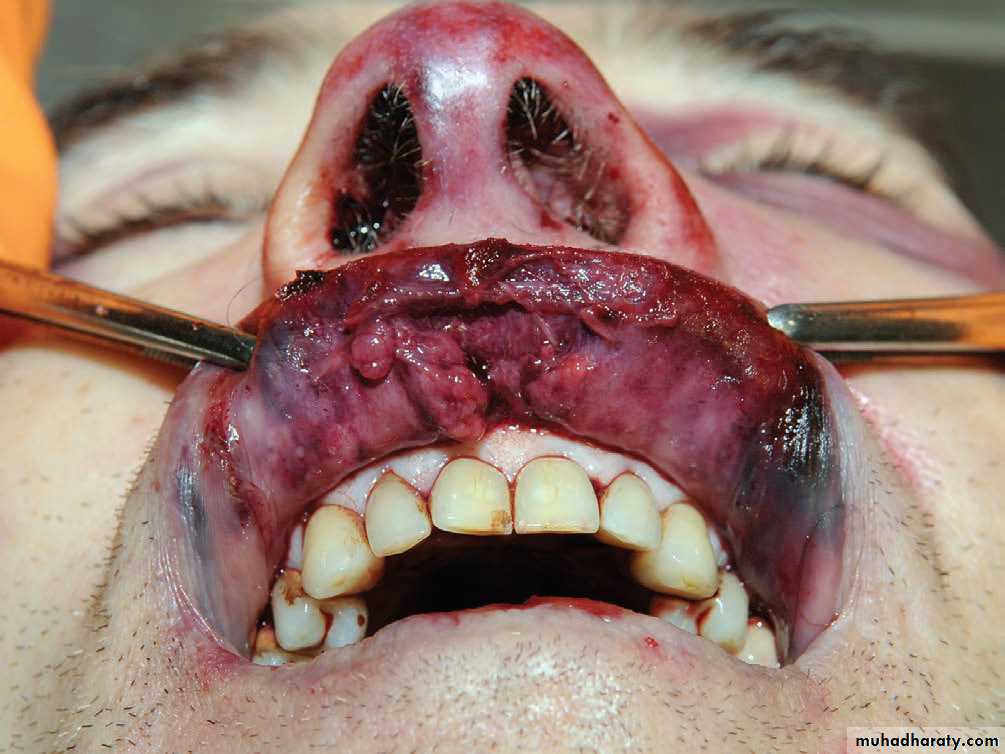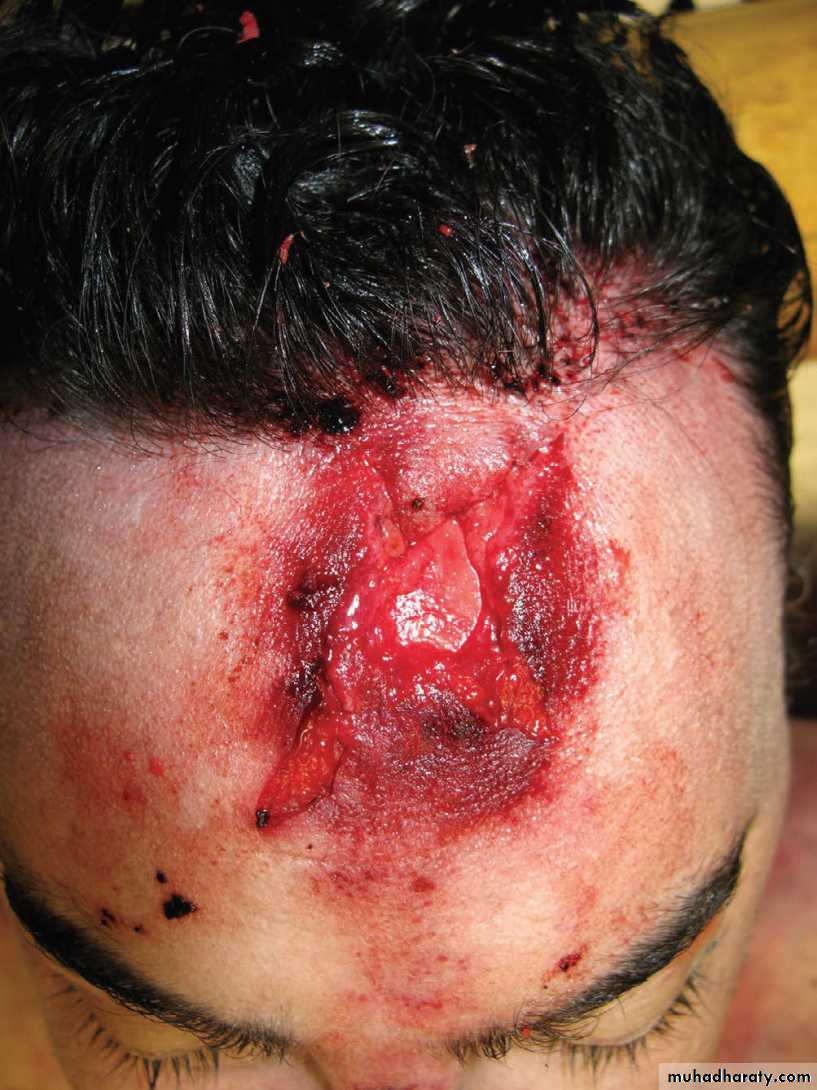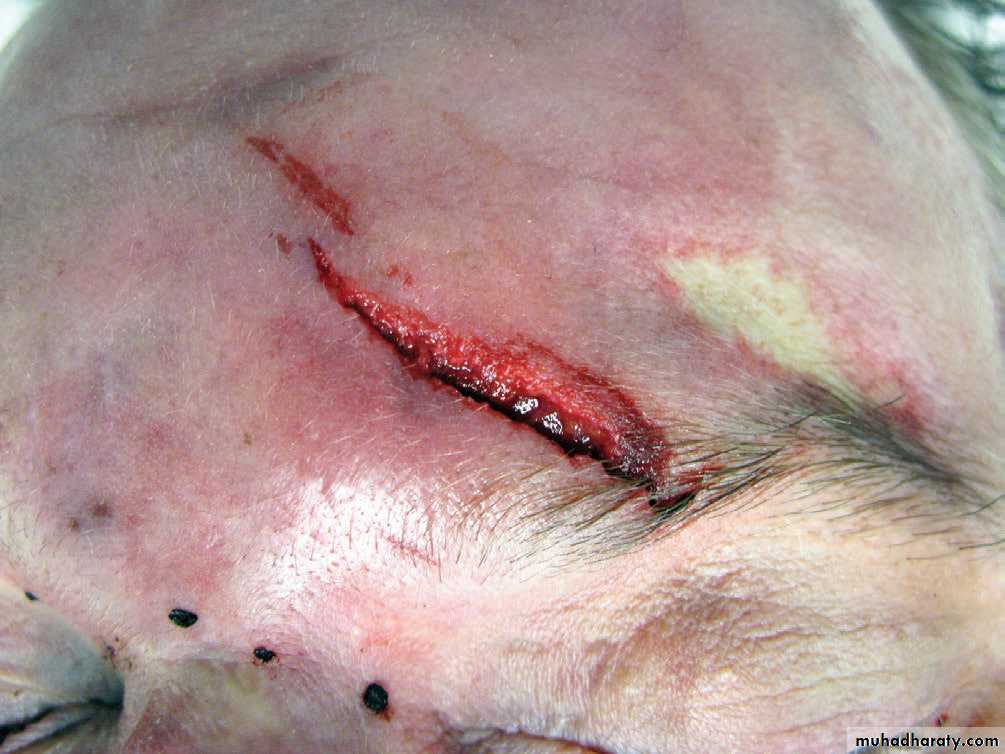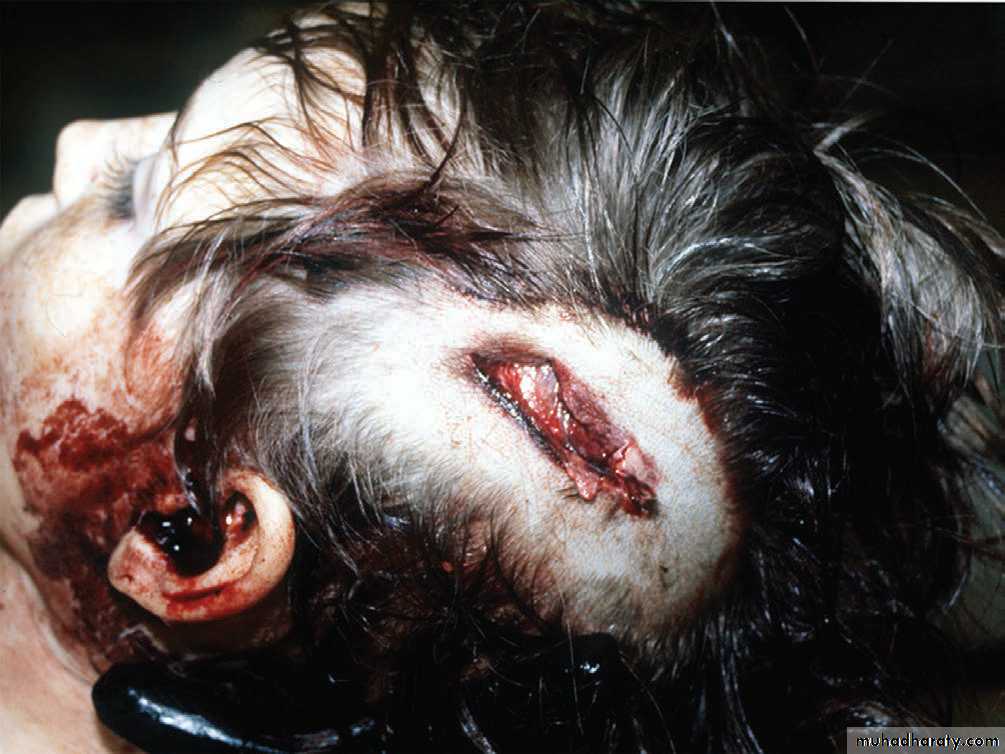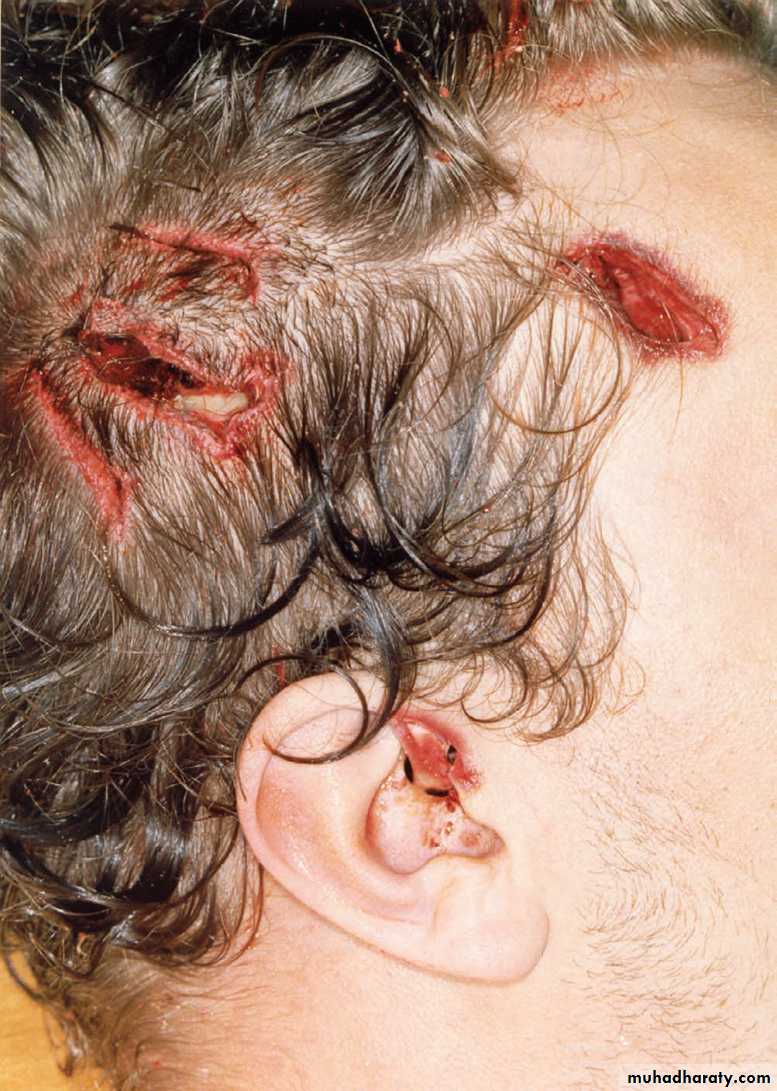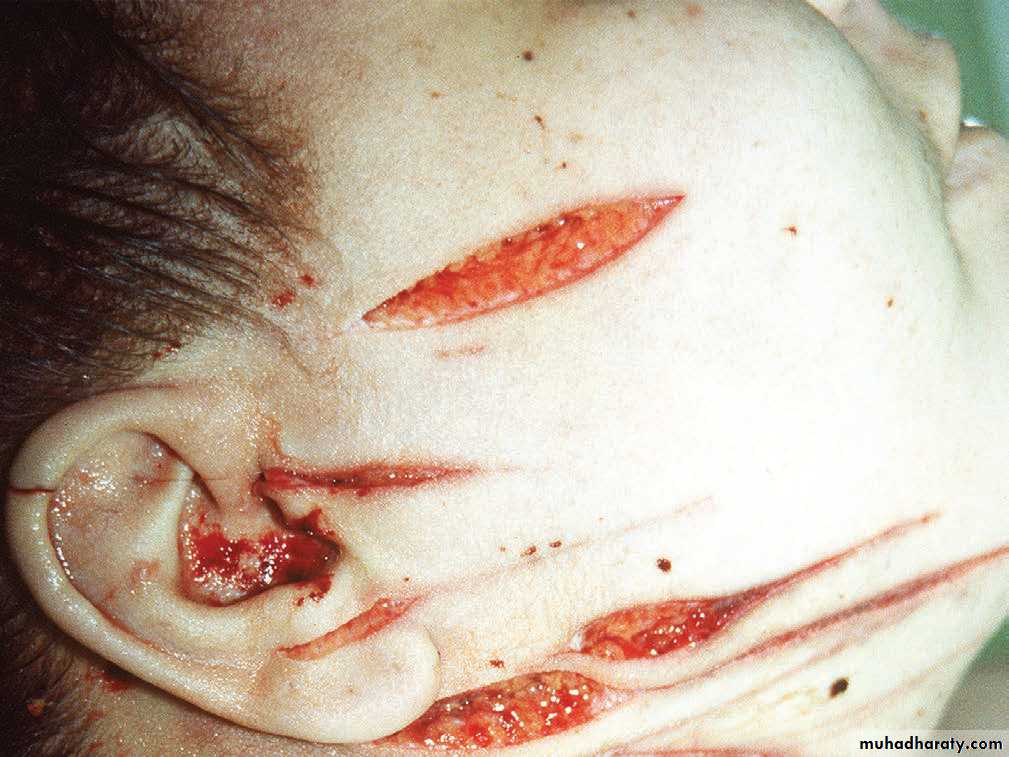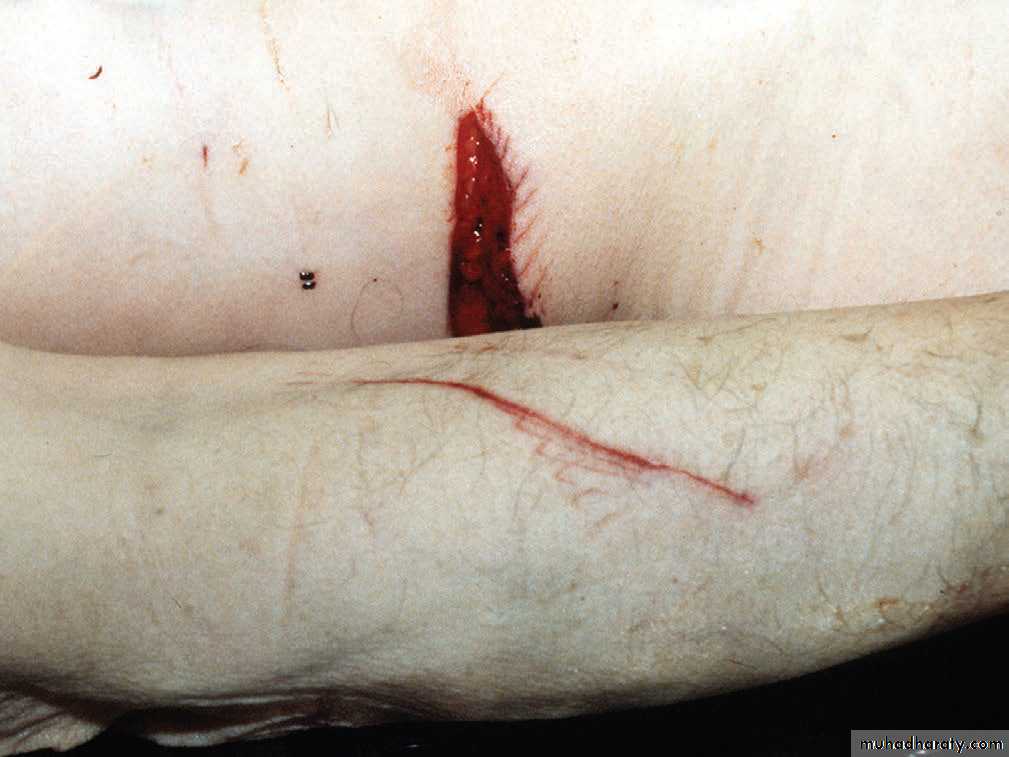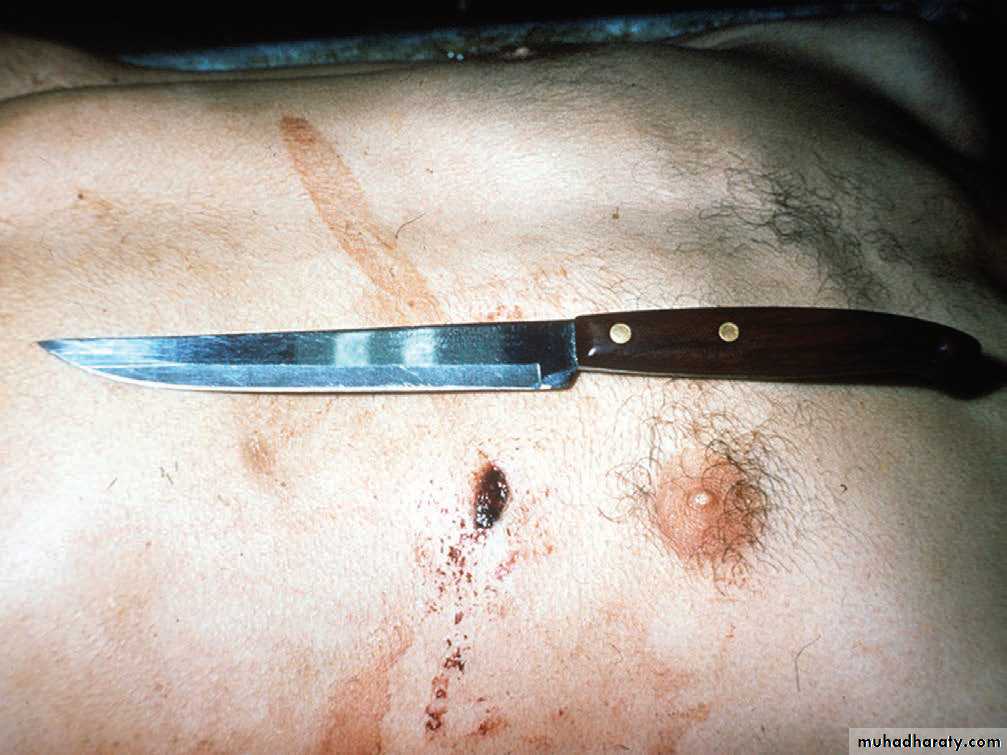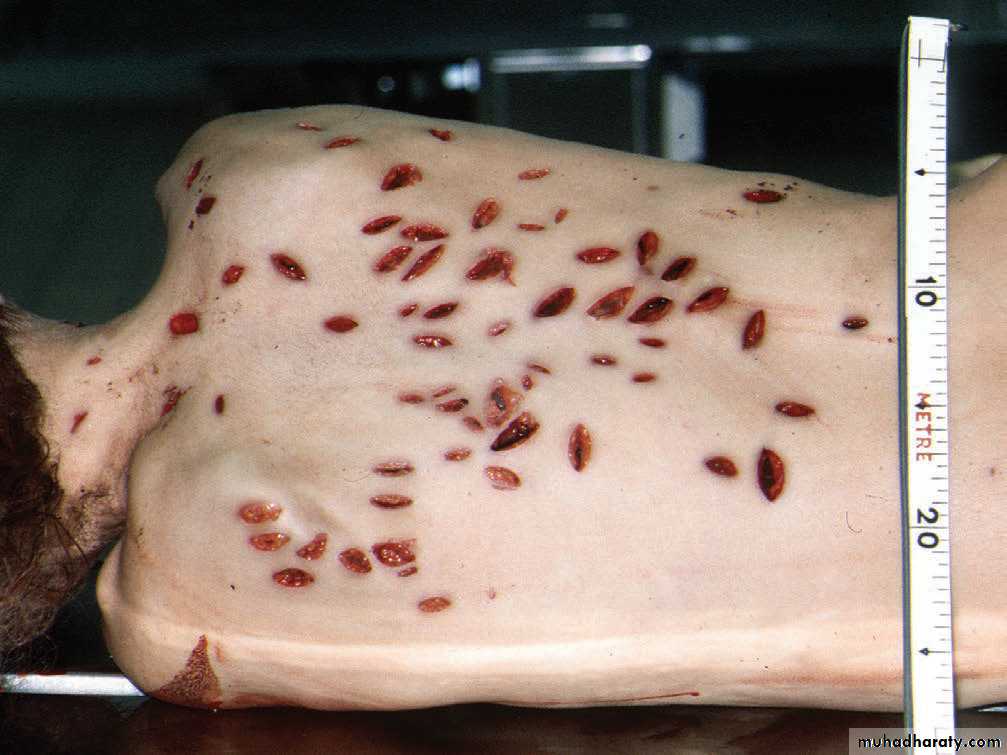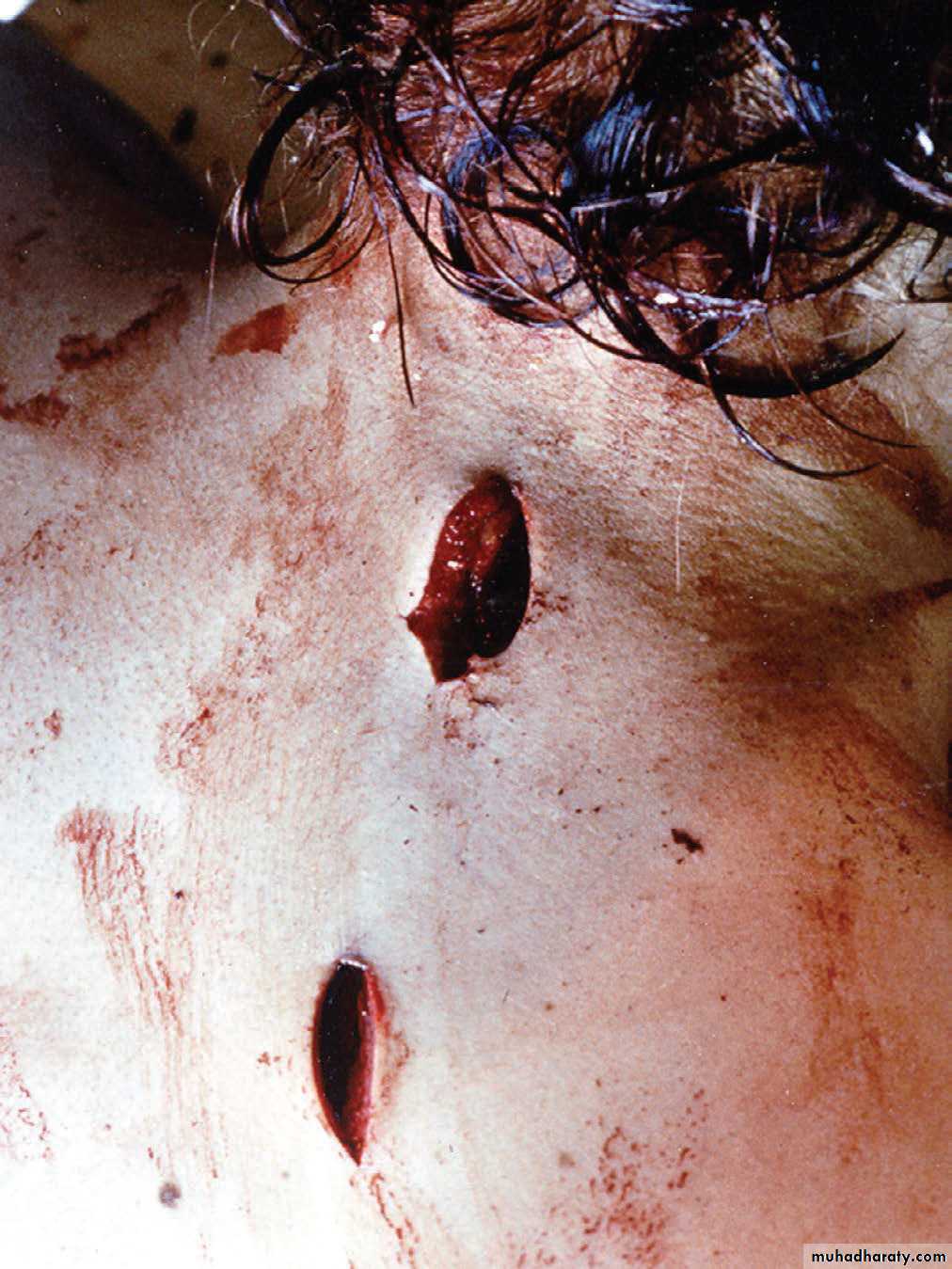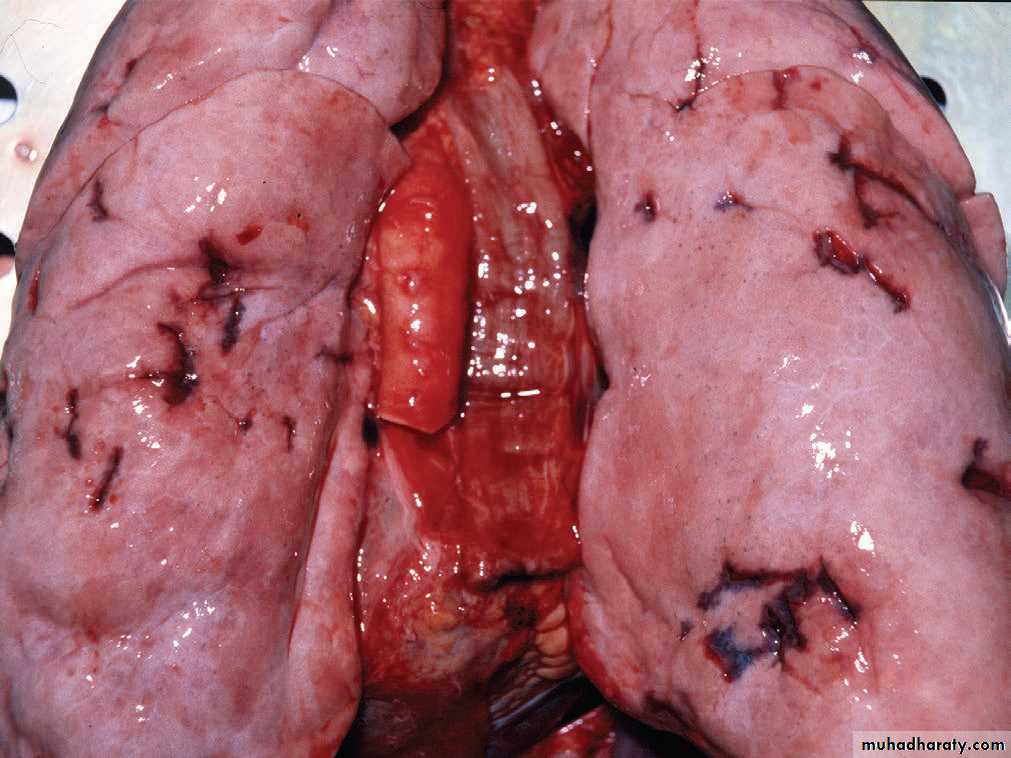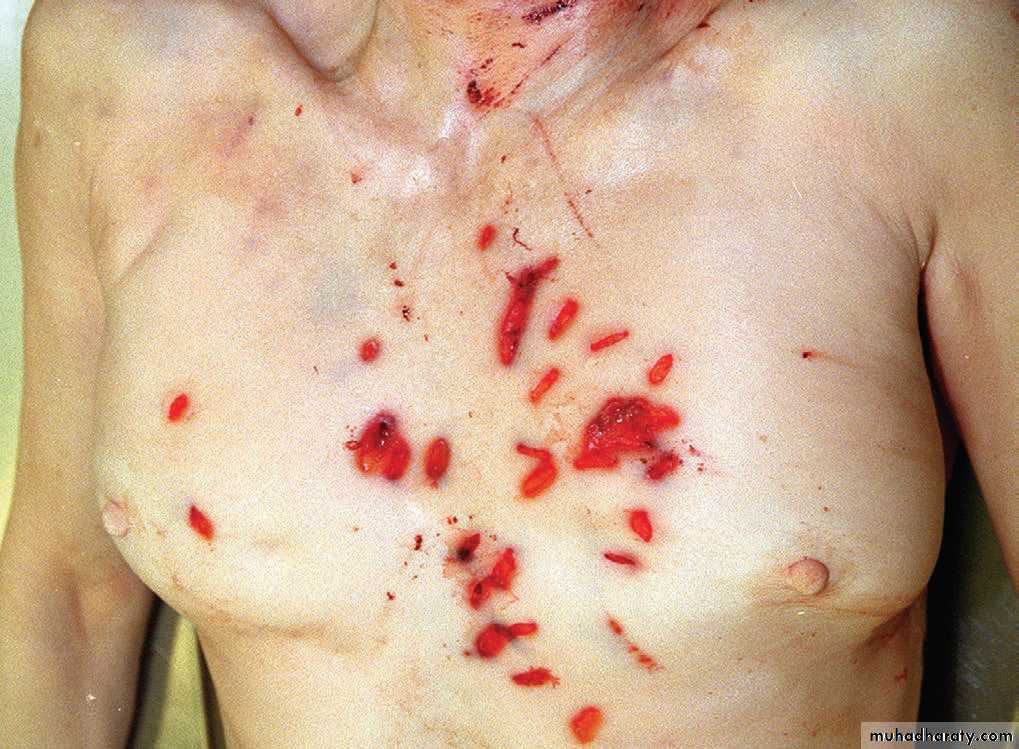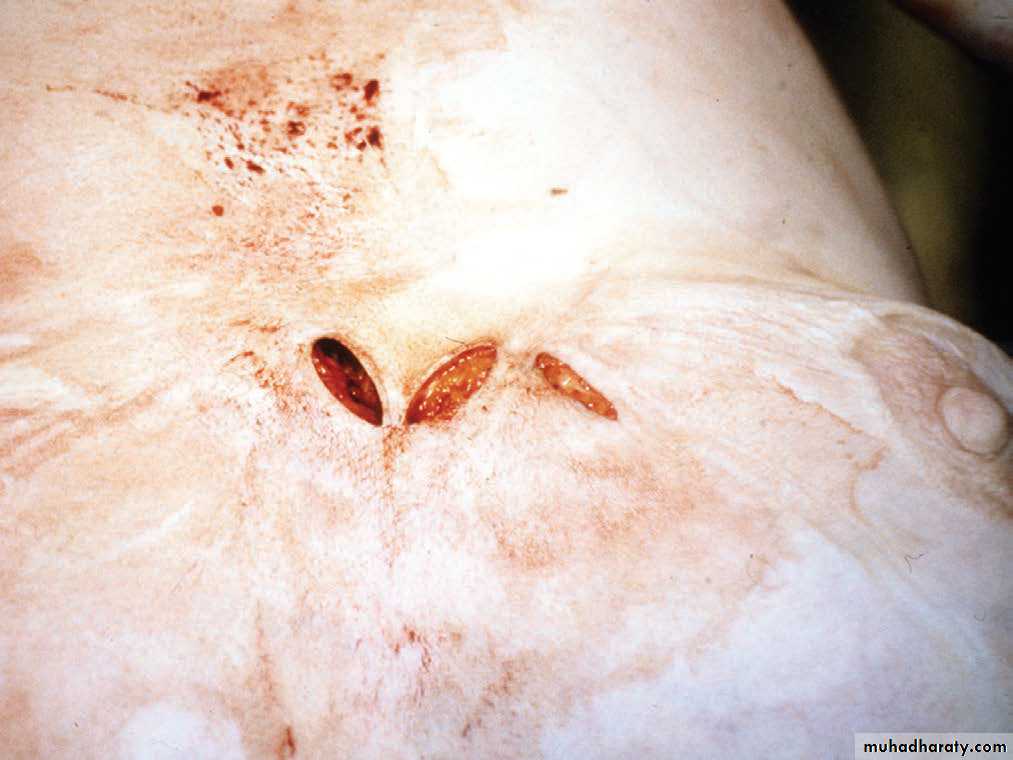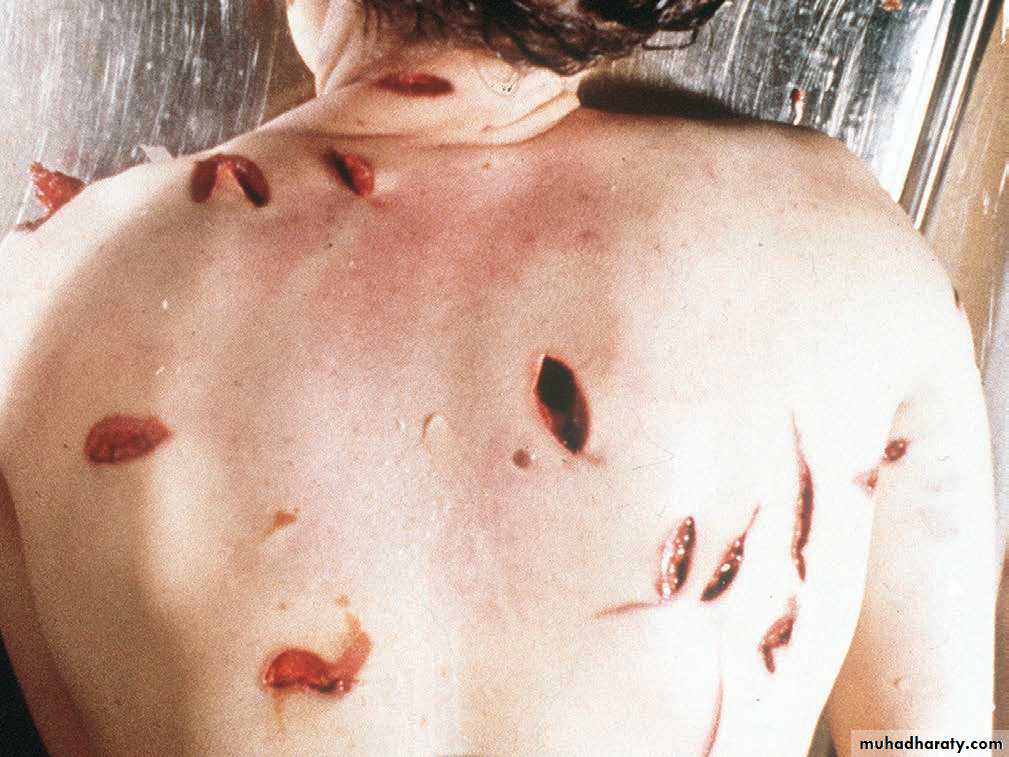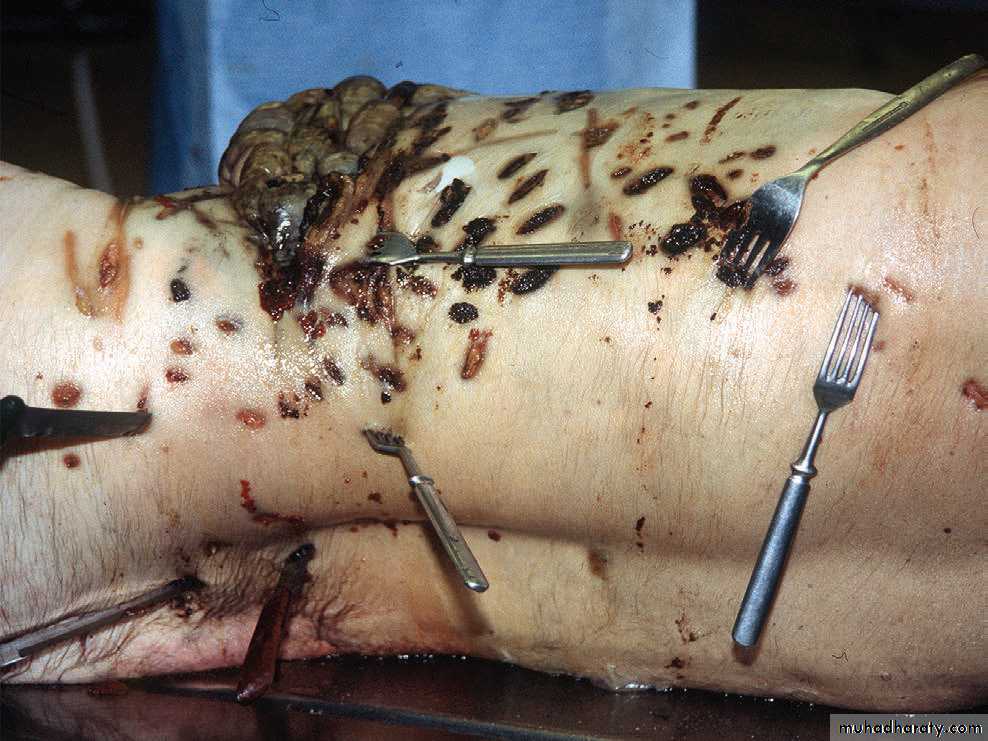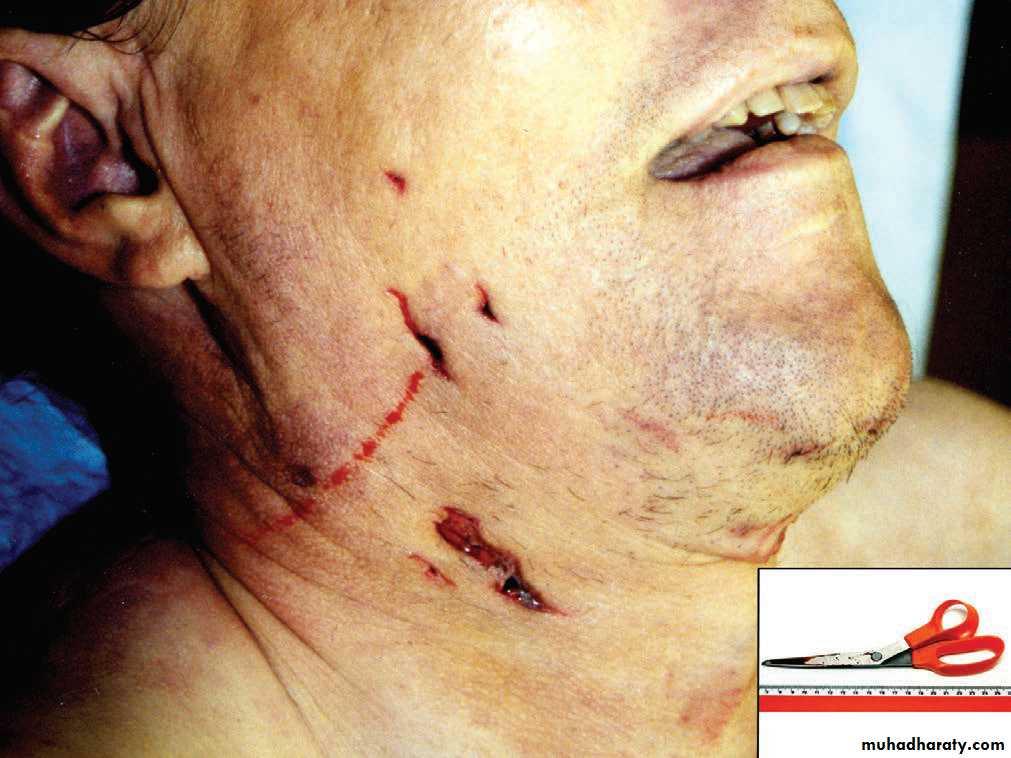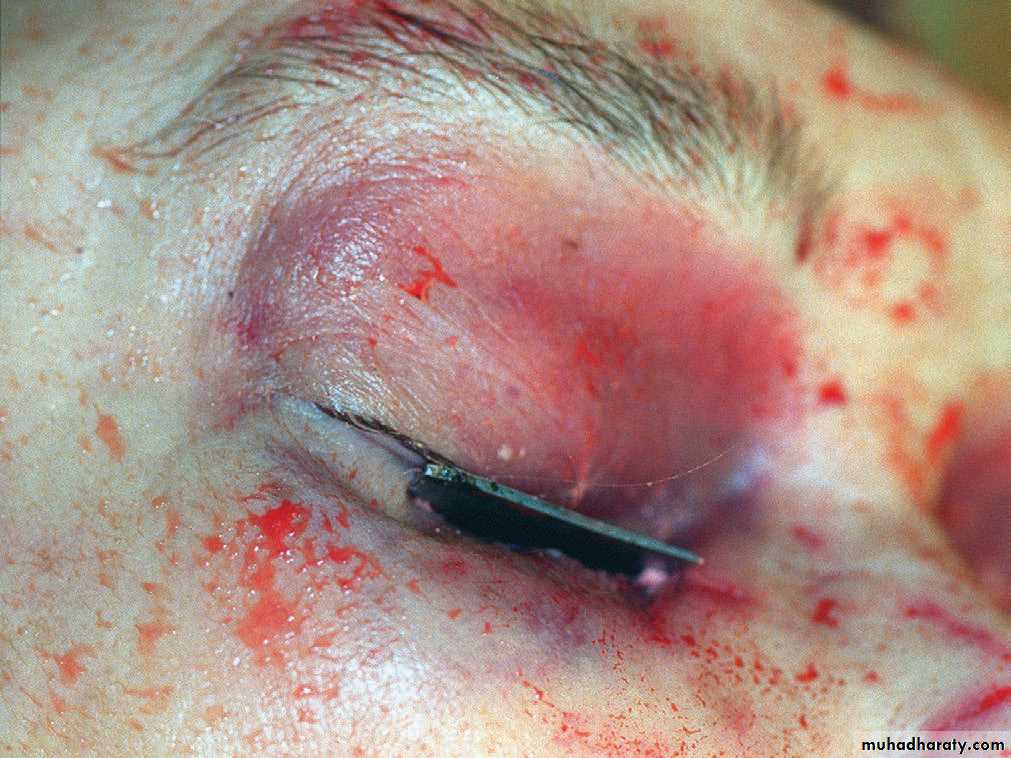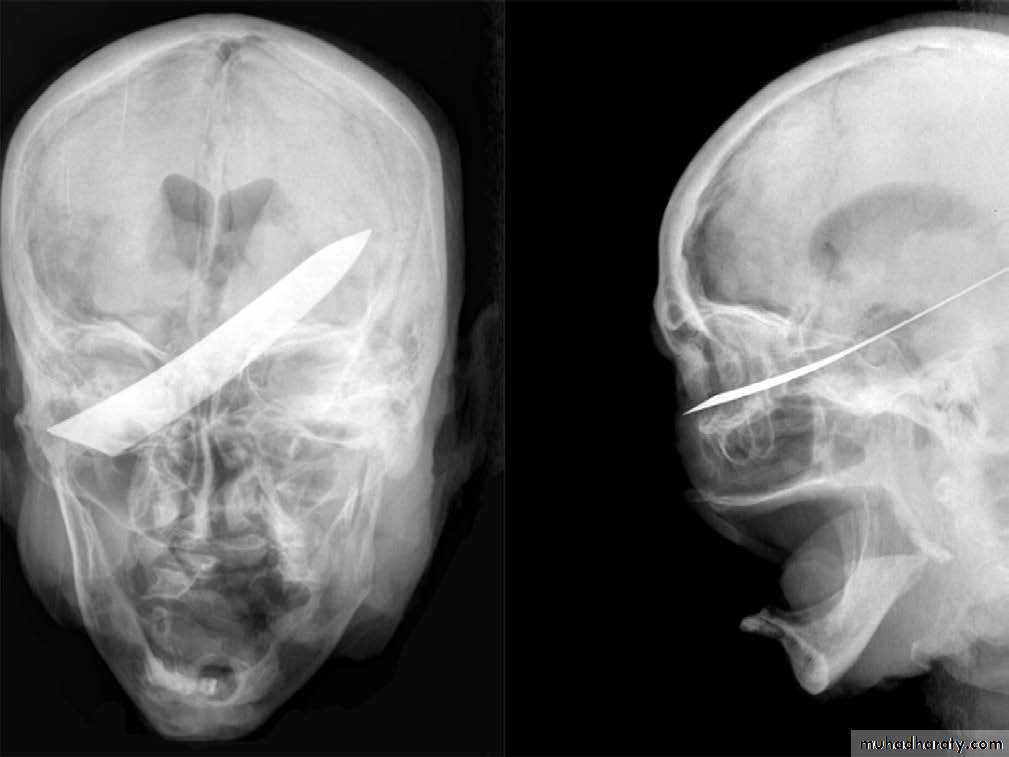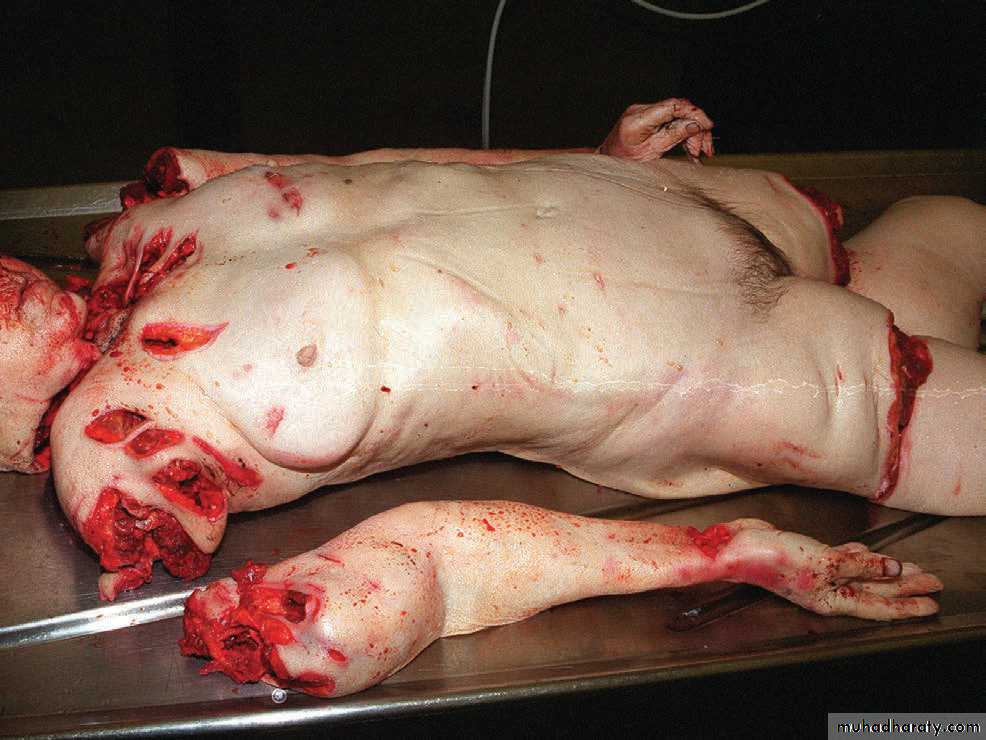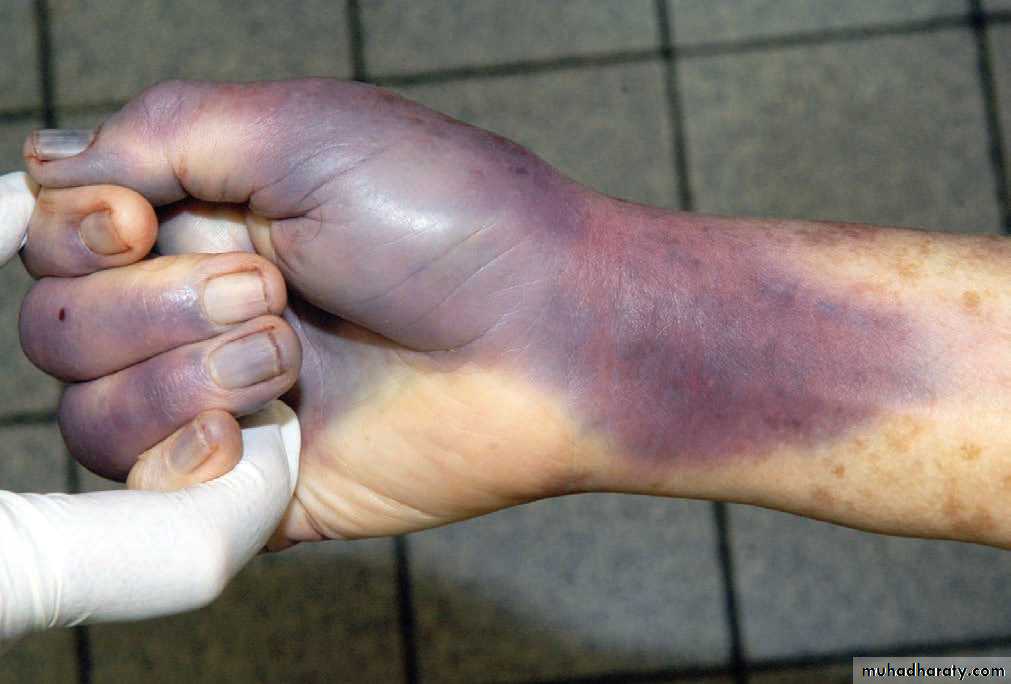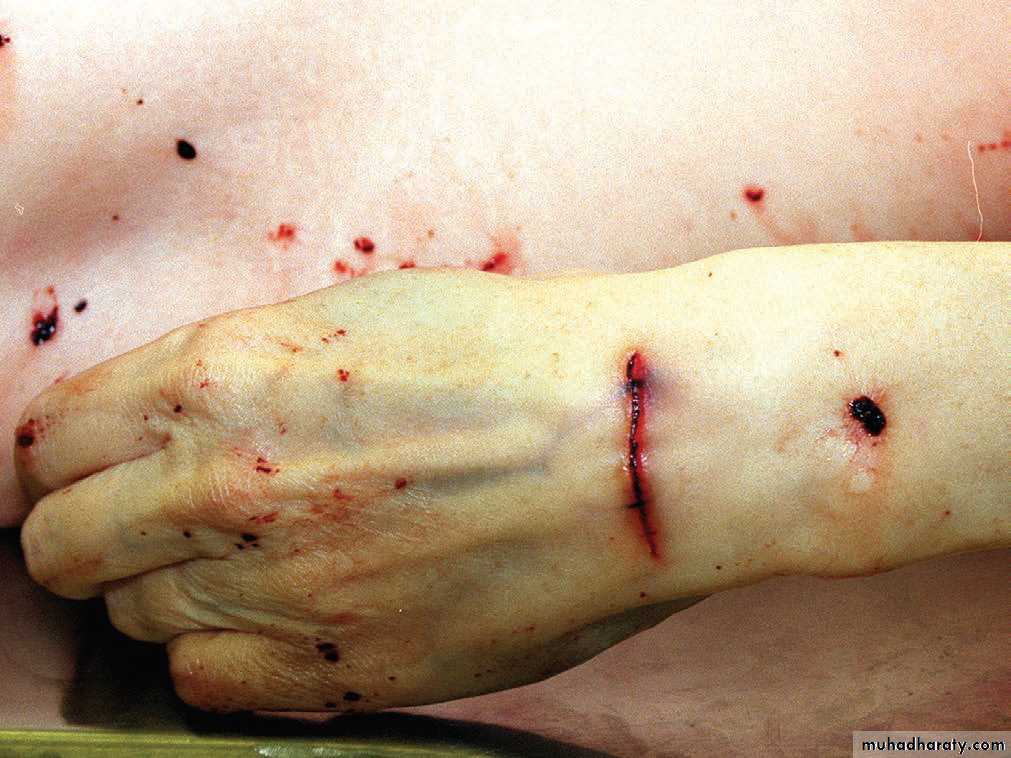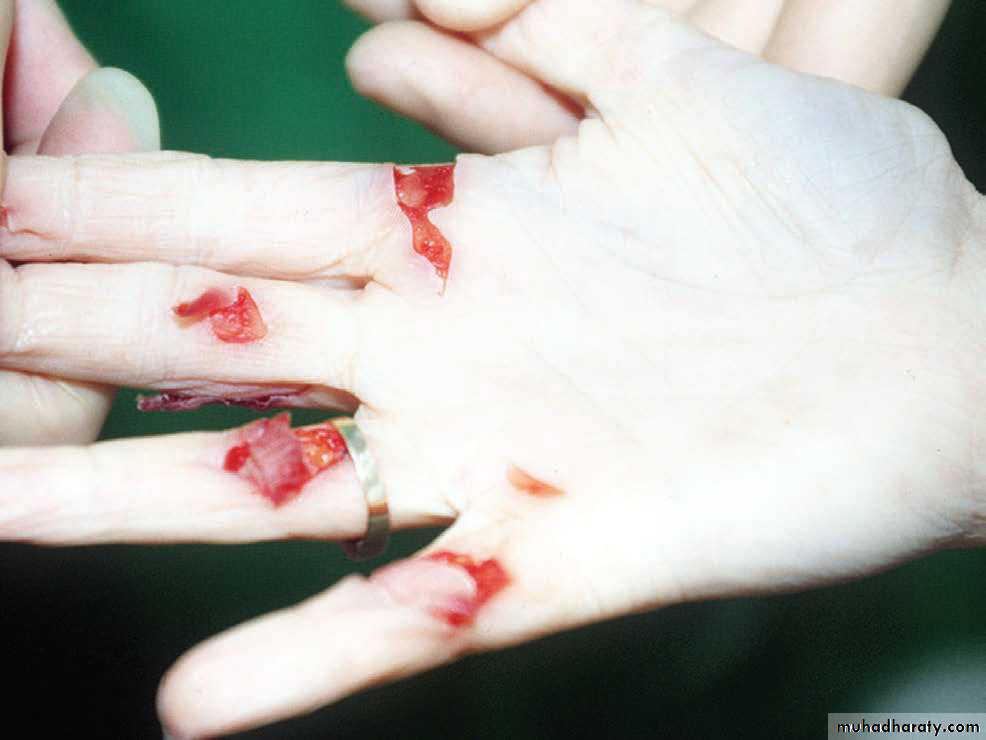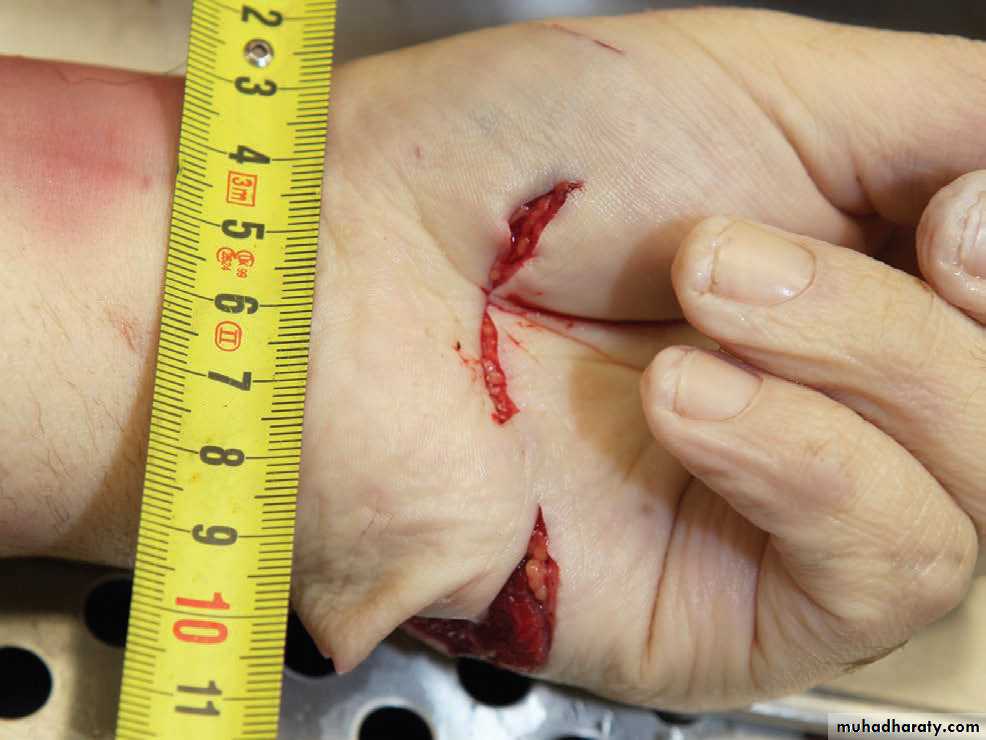Wounds الجروح
Pathophysiology of wounds:الجروح تقسم الى
1. جروح رضية تشمل:
السحجات Abrasions
الكدمات Bruises
الرضوض التمزقية Lacerations
2. جروح حادة وتشمل:
الجروح القطعيةIncisional woundsالجروح الطعنية Stab wounds
الجروح الوخزية او الثقبية Puncturing wounds
Simple abrasion of the skin caused by a perpendicular impact of the head against the side pillar of a car. There is no clear tangential scuffing though most abrasions have some element of sideways contact that damages the epidermis
A linear abrasion or ‘graze’, confined to the upper layers of the skin. The tangential direction of impact of the weapon was from above downwards (along the longitudinal axis of the upper arm), as can be determined by the shreds of epidermis peeled towards the lower end.
Brush abrasion from skidding contact with the road surface. The lesion is partly abraded and partly bruised. The direction of movement can be discerned, as the bruises begin more abruptly below the kneecap, and tail off superficially towards the ankle.
Drag marks on the front of the thighs of a murder victim. In addition to the drag marks there are bruises, and burn injuries above the knees on both sides. Death was caused by stab wounds to the chest.
Abrasions in manual strangulation. The area is more extensive than is usually seen in such circumstances. The large area of superficial damage to the epidermis is caused by sliding movements of the assailant’s hands, the area having become dried and leathery during the postmortem interval. The smaller marks are fingernail scratches
Extensive abrasion of the knees and shins, in a drunk who stumbled amongst furniture before dying of a head injury. The damaged skin has exuded tissue fluid, which has dried post-mortem to produce the dark, leathery appearance
Abrasions and intradermal bruising on the forehead of a swimming bath attendant. He was found drowned when there were no witnesses, but the spacing of the marks exactly matched the ridged tiles at the edge ofthe bath, so it was presumed that he had slipped and struck his head before falling unconscious into the water.
Patterned abrasions from the back edge of a serrated ‘Rambo’ knife. Measurements and photographs with a scale should always be obtained to assist in the identification of the weapon.
Patterned abrasion on forehead due to falling down steps onto a metal grid. Here the abrasions are not produced by tangential force, but imprinted directly by impact at a right angle to the skin
Intradermal bruising showing the pattern of rubber soles of ‘trainer’ shoes on the neck and T-shirt of a homicide victim
Kicking and stamping injury to the face. The nose is bruised from a kick and the patterned rubber sole of the shoe has imprinted intradermal bruising on the forehead. It is essential to obtain accurate photographsand measurements of the shoe-tread pattern, to allow identification of the footwear.
Multiple bruises on the trunk of a victim of child abuse. The bruises are of the ‘finger-tip’ type, caused by heavy prodding by adult fingers. The child died of a ruptured liver.
Bruising on the upper arm, typical of forceful gripping in a struggle. There are contusions from fingers on either side of the biceps, with small abrasions from fingernails.
Extensive bruising of the face due to hitting, kicking and stamping 6 days earlier. The victim had multiple fractures of the facial bones, bilateral serial rib fractures and a tension pneumothorax
Bruises from a beating with a broom handle They are approximately parallel and several, especially the lowermost, show a double ‘tram-line’ appearance typical of the impact of a round or square-section rod. The pressure in the center compresses the vessels so that they do not bleed.
A black eye (periorbital hematoma) of a live victim from a direct fist blow, which has also bruised the bridge of the nose and lacerated the corner of the eye (sutured).
Bruising of the interior of the lip from a blow to the mouth. The lip has been impacted on the underlying teeth, but not sufficiently hard to cause a laceration
Lacerated upper lip from a fist blow to the mouth
Laceration of the forehead with surrounding bruising. The wound is stellate as a result of crushing against the underlying bone. The victim fell down stairs and sustained a fracture of CVII and died of a spinal cord injury.
Simple laceration of the eyebrow. A chronic alcoholic who hit his head when falling at home. Death due to acute pancreatitis
A laceration of the scalp from a blunt weapon, a metal bar. The edges are crushed and abraded, with tissue elements and hair driven into wound.
Homicidal lacerations of the scalp penetrating the skull. Although some of the injuries resemble incised wounds, their margins are crushed, and hairs and tissue strands cross the injuries. The damage was probably inflicted with a metal rod with sharp edges.
Homicidal slashed wounds caused by knife; the length is greater than the depth, unlike stab wounds. The long tails are due to the knife rising from the skin, thus indicating the direction of the slash.
A knife slash of the back showing regular scratches along the margin. This was inflicted with a ‘Rambo’ knife, which has deep serrations along the back edge that have somehow marked the skin on withdrawal
A stab wound and the inflicting knife. The wound is slightly shorter than the width of the blade at the depth of penetration because of sideways gaping and the contractile elasticity of the skin.
Multiple stabs on the back from the same knife,showing differing shapes and size
Two knife wounds in the back. The wounds have a sharper lower edge compared to a rounder upper edge, due to a one-edged blade.
Multiple stabs in the lungs from the same knife with fresh wound haemorrhage and varying wound size according to the angle and depth of the stabs. The lungs appear anaemic due to the massive loss of blood.
Multiple stab wounds from the same knife, showing variations in the size and shape of the injuries. With multiple injuries, it is advisable to number each to facilitate easy reference in the autopsy report and when giving evidence in court.
Three wounds from a single stab with a knife, which was in place when the body was discovered. The knife had entered obliquely through the inner side of the right breast, emerged into the cleavage and re-entered the mid-line. If the knife had not been in situ, interpretation could have been more difficult.
Multiple homicidal knife wounds, all inflicted with the same weapon. This shows the marked variation in wound size from the same knife, caused by rocking and twisting movements of either weapon orvictim.
Multiple homicidal stab and incised woundsinflicted with various kitchen utensils.
Multiple homicidal stab wounds by closedscissors.
Broken blade of a kitchen knife protruding from the eye. The victim was stabbed to death and dismembered thereafter by the perpetrator
X-ray of the skull of the victim in previous case , showingthe position of the knife blade.
Dismembered body of the victim shown in previous case
Defense injuries: extensive bruising on the hand in an attempt to fend off kicks. Such injuries confirm that the victim was conscious and active during the attack, and that it was not made covertly while the victim was unaware.
Defence wound on the back of the hand fromtrying to ward off the knife.
Typical defence injuries in a victim of a knife attack. In grasping the blade to deflect it, there have been cuts across the palmar surfaces of the finger joints and a slash between the thumb and forefinger, together with a cut at the base of the thumb.

